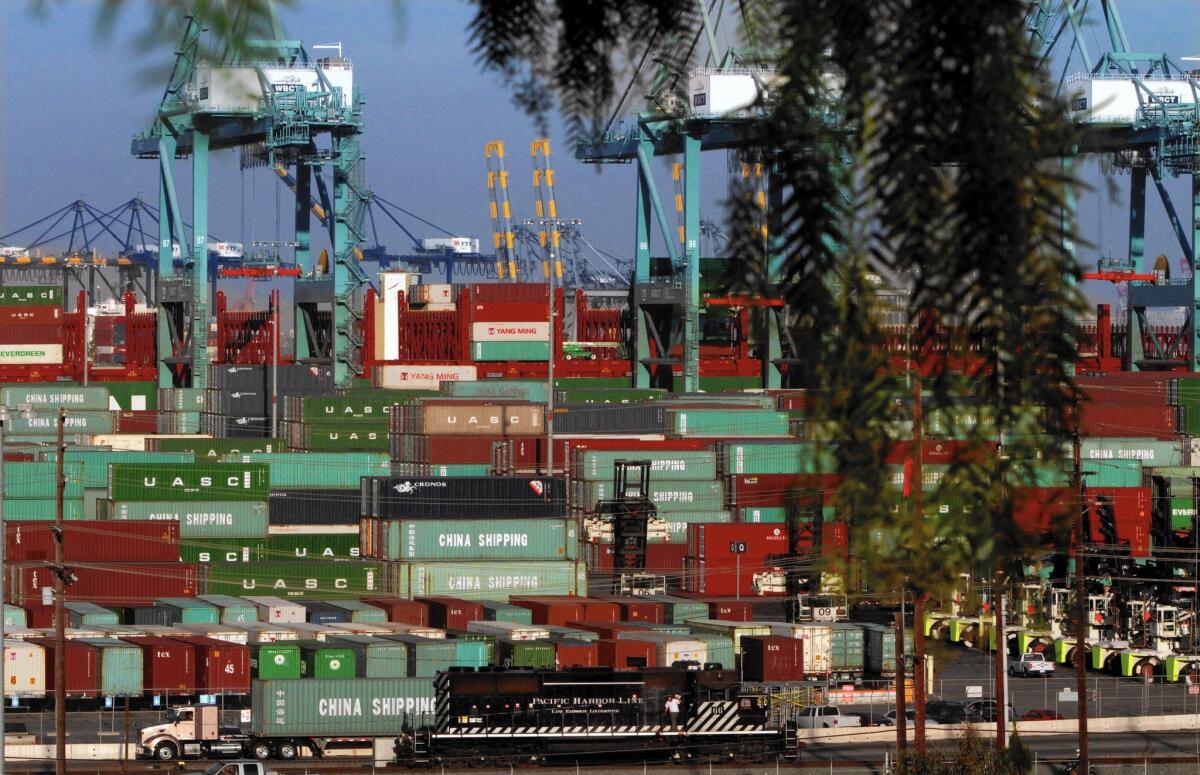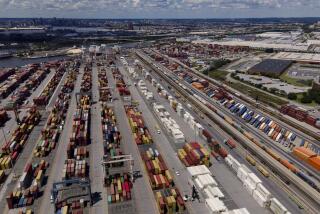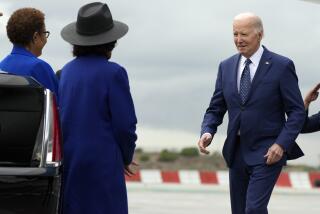Port of L.A. helped pay for cleaner China Shipping vessels--which later stopped docking in L.A.

China Shipping used $5 million paid by the Port of L.A. to upgrade 17 ships so they can use shore power, but the city didn’t get all the promised environmental benefits.
The Port of Los Angeles paid a Chinese government-owned shipping company $5 million in 2005 to equip cargo vessels to plug into electric shore power while at dock to keep their massive diesel engines from polluting neighborhoods near the harbor.
The company, China Shipping, used the money to upgrade 17 ships, but the city didn’t get all the promised environmental benefits. Most of the vessels stopped traveling to Los Angeles in 2010, a Times review of shipping industry data showed.
The ships that took their place on the Asia-to-Los Angeles route were not all equipped for shore power. From 2010 to 2013, a period in which residents were promised that virtually every vessel docked at the terminal would plug in, half left their engines running, port records show. In 2012, 88% left their engines running.
NEWSLETTER: Get the day’s top headlines from Times Editor Davan Maharaj >>
As a result, people who live near the port spent those years inhaling more diesel exhaust — a known carcinogen — than they were promised.
Since 2014, nearly all ships that dock at the China Shipping terminal have plugged in because the newer, larger vessels plying the route now are generally built with shore power in mind, port spokesman Phillip Sanfield said.
The port’s payment to upgrade ships was part of a legal settlement to a dispute that began nearly 15 years ago when residents and environmentalists, citing health concerns, sued to block expansion of the China Shipping terminal, which sits beneath the Vincent Thomas Bridge near central San Pedro.
The port settled the suit in 2004 by promising to impose some of the strictest environmental measures in the maritime industry on China Shipping. Those included requiring that 30% of the vessels docked at the terminal use shore power that year and that all ships at the terminal plug in by 2011.
China Shipping objected. The company was one of the port’s biggest customers and could choose to move some of its operations to other ports in the state. Port officials agreed to pay to upgrade 17 of the firm’s ships.
For the next few years, the company met the steadily rising requirements for the percentage of ships using shore power. But in 2009, during the global economic downturn, former Port Director Geraldine Knatz granted the firm permission to ignore the mandate. She did not disclose the action to the public.
Her action freed China Shipping to use the upgraded vessels in other parts of the world where they might be more profitable because of features they had unrelated to shore power.
Air quality studies show harbor-area residents bear the highest pollution-related cancer risk in Southern California. Per visit, a container ship that runs its engines while docked spews more smog-forming pollution than 40,000 cars release each day, according to emissions data from state and federal environmental regulators.
Critics say the port’s decision to allow China Shipping to avoid the requirements is emblematic of wasteful spending and broken promises by the port.
“That’s just a gift to China Shipping,” said Kathleen Woodfield, one of the San Pedro residents involved in the suit and the settlement negotiations.
China Shipping did not respond to a request for comment.
Last fall, city officials acknowledged that they had allowed China Shipping to ignore clean air mandates from the 2004 settlement without informing the public.
In all, the port has paid China Shipping more than $30 million for costs related to the residents’ lawsuit, according to records recently obtained by The Times under the California Public Records Act. About half of that was compensation for construction delays and business interruption caused by the litigation.
The rest, including $7 million to buy clean-fuel-burning yard equipment to move cargo around the terminal, went to help the firm meet the new environmental demands.
The port offered the inducements to China Shipping because the city had little leverage to force compliance.
When the port paid to upgrade the firm’s vessels, “there was no stipulation for how long the ships would remain calling at the Port of L.A.,” said Sanfield, the port spokesman.
After port officials signed the settlement with residents in 2004, they did not include language in China Shipping’s lease that would have required the company to abide by the new environmental measures, port officials have acknowledged.
The current executive director of the port, Gene Seroka, said he didn’t know why his predecessors allowed that omission, but said, “I would have done it differently and put the mitigation measures in the lease.”
See more of our top stories on Facebook >>
Asked whether the city got its money’s worth from the ship upgrades, Seroka said the investment was worthwhile because it helped show that plugging into shore power was a technically feasible alternative that eventually led to adoption of the 2014 state regulation that now requires 50% of cargo ships to use shore power at California ports.
Knatz said the decision to pay for the ship upgrades was made before she was appointed director in 2006. She declined to answer additional questions from The Times.
Previously, she has said she waived the shore power requirement in 2009 in response to a request from former Los Angeles Mayor Antonio Villaraigosa to be “flexible” with customers during the economic downturn. Villaraigosa has said he does not recall requesting any waivers for China Shipping.
That year, six of the upgraded ships made their final visits to the Port of L.A., according to records provided by the Marine Exchange of Southern California, which tracks commercial ship movements. The next year, three more upgraded vessels made their last call in L.A., as compliance with the shore power mandate began to plummet.
In 2011, China Shipping requested an extension of the waiver and Knatz approved it, noting in a letter to the company’s president that the move would increase emissions but should not push residents’ estimated cancer risk beyond the port’s “significance threshold” of 10 cases per million people, a limit used widely by air quality regulators and health officials.
Scott Fruin, a professor of preventive medicine at USC and an expert in assessing exposure to air pollution, said port officials underestimated the health consequences. A proper analysis would have shown that allowing ships at the terminal to idle rather than plug in would increase cancer risk to about 18 in 1 million, Fruin said.
The most recent assessment by the South Coast Air Quality Management District found that pollution in and around the port complex poses a cancer risk more than double the rate found in less-polluted communities, such as central and southern Orange County.
Seroka, who was appointed in 2014 by Mayor Eric Garcetti, said overall air quality at the port has improved sharply since 2005, thanks to $350 million invested in other programs, including a port-wide initiative to require cleaner trucks and installation of equipment for ships to plug in at other terminals. But he acknowledged the air would have been cleaner if his predecessor had enforced the shore power rules at the China Shipping terminal, one of the busiest at the port and among the closest to area homes, schools and businesses.
In an audit released last month, the port acknowledged that another major terminal operator, TraPac, whose facilities are a few hundred yards from homes in Wilmington, has also failed to meet shore power requirements and other pollution-reduction mandates.
Seroka said the port is now working “to get back to a position of clean air and trust in the community.”
Over the last six years, port officials have attempted without success to get China Shipping to show it has complied with other environmental measures promised to residents, including a requirement to use clean-fuel-burning equipment to move cargo around the terminal.
City officials have met with China Shipping executives in L.A., made several trips to the firm’s North American headquarters in New Jersey and embarked on at least two negotiating missions to China to no avail, according to correspondence between the port’s lawyers and the company.
Homeowners involved in the original lawsuit have been negotiating with port officials over potential remedies, including punitive damages, said Chuck Hart, president of San Pedro Homeowners United.
“There has to be consequences. They hoodwinked us,” Hart said. “If someone died, or suffered physically from the bad air, you can’t take that back.”
ALSO:
New home and restaurant concealed drug tunnel at U.S.-Mexico border, officials say
Former San Diego Mayor Bob Filner testifies he didn’t sexually harass anyone
After Baca guilty plea, focus of L.A. jail corruption case now turns toward trial of his top aide
More to Read
Start your day right
Sign up for Essential California for news, features and recommendations from the L.A. Times and beyond in your inbox six days a week.
You may occasionally receive promotional content from the Los Angeles Times.








